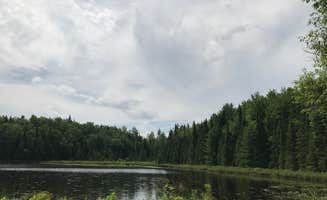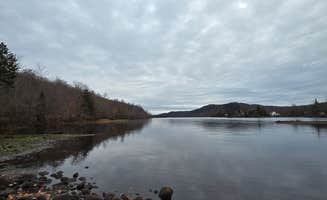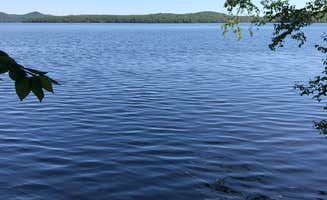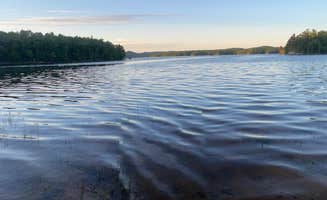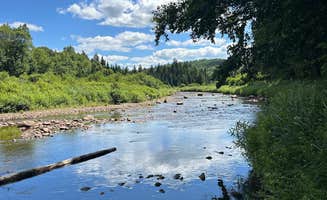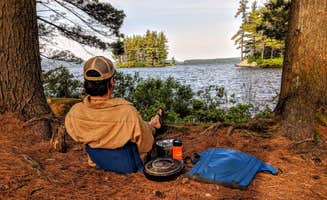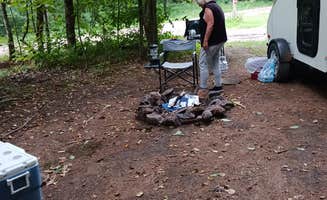Dispersed camping sites near Thendara, New York require various vehicle types for access, from standard cars to high-clearance SUVs depending on location. Most primitive camping areas around Thendara sit within the western Adirondack region at elevations between 1,600-2,000 feet, creating cooler temperatures than surrounding lowlands. The region features extensive waterways with numerous pond and lake access points for paddlers and anglers seeking backcountry experiences.
What to do
Kayaking and canoeing: Stillwater Reservoir provides exceptional paddling opportunities with multiple waterfront campsites accessible only by boat. "This was my 3rd trip to Stillwater in 3 yrs and it gets better each time! Next year we took a canoe to our site, it was July, warm weather, warm water and the bugs were not terrible, we were at site 1, secluded in a cove, not a lot of traffic," notes one visitor to Stillwater Reservoir.
Swimming at remote beaches: Many primitive sites feature natural swimming areas. At Blue Lagoon Primitive Dispersed Camping, one camper reports: "A short hike in to a great beach for swimming or paddling. We've stayed here many times in tents and hammock tents. The swimming is fantastic- water is clean and clear."
Hiking to fire towers: Several trails near dispersed camping areas lead to historic fire towers. "This campsite is right down the road from the fire tower trail," notes a camper at Stillwater Reservoir. The Stillwater fire tower trail is accessible from multiple primitive camping areas and provides panoramic views of the surrounding wilderness.
What campers like
Island camping: Many dispersed sites in the region include island options for maximum privacy. "We kayaked to Long Island and stayed for a weekend. It was quiet and had the whole island to our self. Would recommend if you want to break away from technology because you get zero service out there," writes a camper at Stillwater Reservoir.
Waterfront solitude: At North Lake Reservoir Campground, campers appreciate the lakeside locations. "32 sites all around the lake. Some are walk in right on the lake. Quiet, peaceful, and clean. Make sure to take a left at the start of the lake, the right is all private road and you will have to turn around," advises one visitor.
Wildlife viewing: The remote nature of these sites creates excellent wildlife observation opportunities. "We saw Bald Eagles and Loons, enjoyed swimming, canoeing and paddleboarding with the family," shares one camper about their Stillwater experience. The extensive shorelines and undeveloped lands create natural habitats for many Adirondack species.
What you should know
Cell service limitations: Be prepared for complete disconnection at most sites. At Powley Road in Ferris Wild Forest, campers note: "There is zero Verizon cell service in the whole area. So plan accordingly." Another camper confirms: "No AT&T cell service in this area."
Water treatment requirements: All water sources require treatment. "You should bring water or something to filter it from the reservoir," advises a Stillwater camper. Most sites have no potable water sources, requiring campers to filter from lakes or carry in their own supply.
Access challenges: Many sites require careful navigation or special vehicles. "The road is rough but easily doable if you take it slow," notes a camper at Horseshoe Lake about County Road 421. At Cod Pond, a visitor cautions: "A car is not recommended. Possible to turn around but you definitely need a smaller SUV."
Tips for camping with families
Island adventure spots: Family-friendly island campsites provide unique experiences for children. At Cranberry Lake Backcountry Sites, one family found: "We spent 3 nights backcountry camping on Catamount Island in Cranberry Lake and absolutely loved it! The sunsets from the island were truly incredible. Each site has a picnic table and fire ring."
Water-based activities: Many sites offer child-friendly swimming and paddling areas. "Our spot had gorgeous waterfront to it, a stone fire circle where someone had left extra fire wood, and ample trees. The season had had unusually low water all over and it left a really unusual landscape on the beach to explore," shares a Stillwater camper.
Bug preparation: Insect protection is essential for family comfort. "The bugs were terrible," notes a camper at Cod Pond Dispersed Pull-Off. For hiking, another advises: "While the mosquitoes weren't bad at the campsite itself or while kayaking, they are terrible on the trails this time of year; so bring your bug spray, or better yet, bug shirts!"
Tips from RVers
Limited site options: Few primitive sites accommodate larger vehicles. At Cod Pond Dispersed Pull-Off, a visitor notes: "The site has its own private road. A car is not recommended. Possible to turn around but you definitely need a smaller SUV." Most sites require small RVs or truck campers rather than larger motorhomes.
Seasonal road conditions: Access roads deteriorate significantly during spring thaw and after heavy rains. "Decent site right off of the 'main' road. 'Main' because it was quiet. Easy to access via a short dirt road, but also easy to miss," shares a Cod Pond camper.
Power limitations: With no hookups available, RVers must be fully self-contained. "As it's a forest, the sites are pretty shaded, so solar and Starlink may present challenges," notes a visitor to Horseshoe Lake about technology options for extended stays.


